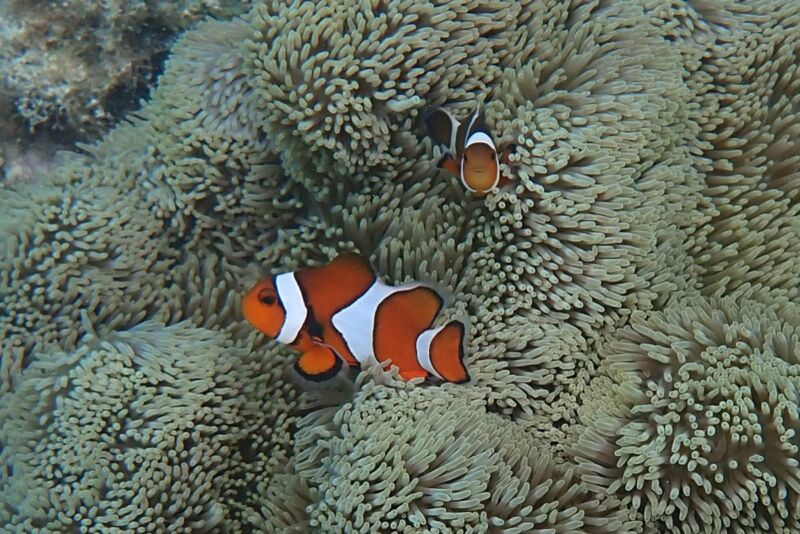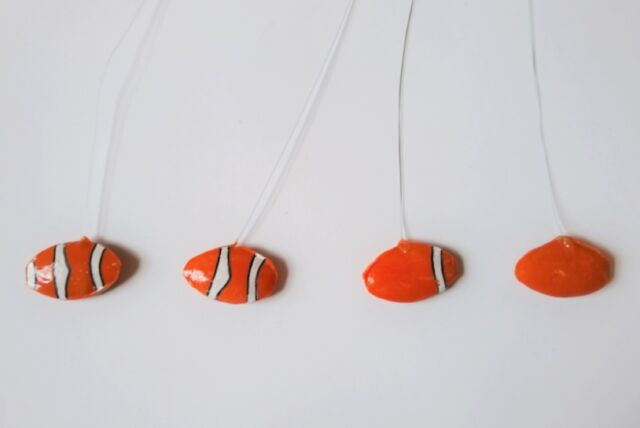
Kina Hayashi
Many people tend to think of clownfish, with their distinctive white bars against an orange, red, or black background, as a friendly sort of fish, perhaps influenced to some extent by the popular Pixar film Finding Nemo. But clownfish can be quite territorial when it comes to defending their host anemone from intrusion by others, particularly those from their own species. A new paper published in the Journal of Experimental Biology describes how clownfish determine if a fish approaching their home is friend or foe by “counting” the number of white bars or stripes on their bodies.
As previously reported, mathematical ability is often considered uniquely human, but in fact, scientists have found that many animal species—including lions, chimpanzees, birds, bees, ants, and fish—seem to possess at least a rudimentary counting ability or number sense. Crows can understand the concept of zero. So can bees, which can also add and subtract, as can both stingrays and cichlids—at least for a small number of objects (in the range of one to five). Some ants count their steps.
This so-called “numerosity” simply refers to the number of things in a set, according to cognitive psychologist Brian Butterworth, an emeritus professor at University College London and author of Can Fish Count? What Animals Reveal About Our Uniquely Mathematical Minds. It has nothing to do with reasoning or logical mathematical intelligence. This is information that will be in the environment, and counting animals must have some mechanism for extracting this numerical information from the environment. But it nonetheless makes for a fascinating field of study.
In 2022, Kina Hayashi of the Okinawa Institute of Science and Technology (OIST) and several colleagues found that clownfish display more aggressive behavior (e.g., chasing or biting) toward fish (or fish toys) with vertical bar patterns compared with fish with horizontal stripe patterns and that this aggressive behavior lasted longer when directed at fish with vertical bars versus horizontal bars. This behavior appears to influence the position of fish species between host anemones and coral reefs: No fish with vertical bars sought shelter in host anemones, while several species with vertical bars were found in the surrounding coral reefs. But it wasn’t clear how the fish recognized the color patterns or what basic rules controlled this signaling. The study results suggested that it wasn’t based on the mere presence of white bars or how much white color was present on a given fish’s body.

This new study builds on that earlier work. This time around, Kayashi and co-authors raised a school of young common clownfish (A. ocellaris) from eggs to ensure that the fish had never set eyes on other species of anemonefish. At six months old, the fish were introduced to several other clownfish species, including Clarke’s anemonefish (A. clarkii), orange skunk clownfish (A. sandaracinos), and saddleback clownfish (A. polymnus).
The researchers placed different species of clownfish, with different numbers of white bars, in small cases inside a tank with a clownfish colony and filmed their reaction. Because they were in a controlled tank environment, there was no chasing or biting. Rather, aggressive behavior was defined as staring aggressively at the other fish and circling the case in which the other fish were held.
They followed up with a second set of experiments in which they presented a colony of clownfish with different plastic models painted with accurate clownfish coloration, with differing numbers of white stripes. The researchers also filmed and measured the degree of aggressive behavior directed at the different plastic models.
Clownfish showing aggression toward another fish with similar stripes. Credit: Kina Hayashi
The results: “The frequency and duration of aggressive behaviors in clown anemonefish was highest toward fish with three bars like themselves,” said Hayashi, “while they were lower with fish with one or two bars, and lowest toward those without vertical bars, which suggests that they are able to count the number of bars in order to recognize the species of the intruder.”
Hayashi et al. cautioned that one limitation of their study is that all the fish used in the experiments were hatched and raised in an environment where they had only encountered other fish of their own species. So, they could not conclusively determine whether the observed behavior was innate or learned. Other species of clownfish also use the same anemone species as hosts, so aggressive behavior toward those species might be more frequent in the wild than observed in the laboratory tank environment.
Journal of Experimental Biology, 2024. DOI: 10.1242/jeb.246357 (About DOIs).

